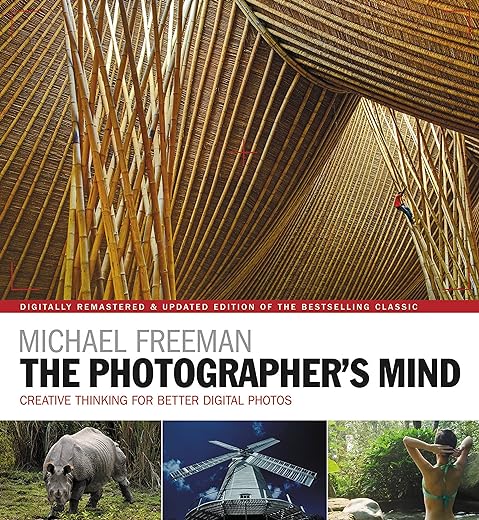The Photographer’s Mind Remastered: Creative Thinking for Better Digital Photos (The Photographer’s Eye)
£7.00£19.00 (-63%)
You’ve done your research. You’ve bought your camera. You’ve learnt how to use it. Now what?
The secret behind a good photograph is not your camera. It’s not even the scene viewed through the viewfinder. It’s the mind of the photographer which turns an average photograph into an exceptional one.
In The Photographer’s Mind, professional photographer and author Michael Freeman unravels the mystery behind the creation of a photograph and reveals how to capture photos that really make you feel something.
The aim of this book is to answer what makes a photograph great, and explore the ways that top photographers achieve this goal time and time again.
The Photographer’s Mind will provide you with invaluable knowledge on:
· Avoiding cliché
· The recurring nature of trends
· Style and composition
· Capturing light
· How to handle the unexpected
Read more
Additional information
| Publisher | 1st edition (5 April 2018), Ilex Press |
|---|---|
| Language | English |
| Paperback | 192 pages |
| ISBN-10 | 1781575649 |
| ISBN-13 | 978-1781575642 |
| Dimensions | 23.81 x 1.59 x 25.72 cm |










by Ray
As novice getting back into photography, I struggled with “The Photographer’s Eye” – it seemed to take a little while/re-reading for the concepts to take hold but after that, I enjoyed that book.
As per the first book, this is aimed at the intermediate/advanced photographer and as such does not cover technical competencies (shutter speed/aperture/iso etc).
This book to me is a continuation of his previous book and I feel without having read/be aware of the solid concepts/techniques of composition, the reader may be a little lost.
This book takes the reader through and expanding on the ‘why’s of compositional elements and considerations for certain situations. There’s a section in the book that provides a small case study for one of Freeman’s images, and whilst not a great image, the thought process and considerations made whilst deciding on the final composition/light control etc is very much appreciated.
One small issue I have is related to the layout of the items on some pages. Whilst Freeman’s writing style is flowing, the pages contain images with captions and the layout does not really provide the reader will clear breaks for us to explore the images/captions, before returing to the main text. With this, I found myself jumping between the images, the captions and the main text and getting ahead of myself. The publishers have missed reading Freeman’s section on “leading the eye”.
If you enjoyed and learned something “The Photographer’s Eye” and want the ‘why’ to the ‘what’, this is a good choice. Throuroghly recommended for anyone wishing to improve.
by Ning Zhao
As all kinds of cameras becoming ubiquitous, sheer volume of pictures explode, there is more and more democracy in the appreciation of good photography. What makes a good photography? Is there really any standard nowadays? And, if yes, how to achieve the quality? Mr. Michael Freeman has tried to answer these questions in a series of books.
In the first book of the series “The Photographer’s Eye”, he addressed some aspects of a solid composition: gestalt theory, right choices of tools for different purposes, necessary skills for capturing one’s idea, etc. The Photographer’s Mind is the second book in this series. It starts right from where the first book ends: the psychological study of what makes a good composition. After all, once you’ve learnt your tools, got your hands swift enough and known the gestalt rules, you’ll need to know more about what makes a good photography in order to advance. This enters the realm of psychology. However elusive this topic is, in “Chapter 1: Intent” of this book, the author analyses the psychology of photo appreciation in seven selected aspects, largely focusing on the choice of arrangement of the image contents.
“Chapter 2: Style” is more on available options of graphical styles to go for rendering your intent. This chapter goes further in the field of gestalt philosophy of composition.
“Chapter 3: Process” talks about practice. Concrete methods for building a sophisticated compositional mind are discussed here. The author is a good guide.
Like Mr. Freeman’s other books, this book is again elaborated in stylish and non-pretentious text. A real pleasure to read as essays. Points are also explained or presented with content-rich and beautiful photographs, as well as informative illustrations. Each section in chapter 1 and 2 provides an “extended reading” subsection. The materials suggested in extended readings surely widen the horizon of your photographic mind.
I strongly recommend this book to people having ambition of advancing the quality of their photographs, or sheerly enjoying intellectual contemplation from reading good English.
by ShammyB
Bookshops are awash with photography books. The problem for the intermediate/advanced shooter is that irrespective of the cover blurb, most of those books are for beginners.
The Photographer’s mind is not for beginners. It is one of the few photography books that truly is for intermediate/advanced photographers. It maintains the level of quality needed to meet its audience throughout. You are not expected to flick through the first 50% of yet another ‘padded out with basic photography’ type book as it yet again slowly trudges through all the things you know already (basic shutter/aperture, camera lenses, exposure modes, ISO, rule of thirds, layer adjustments and correction). Instead, you are treated as a competent user.
A criticism of the book would be that the author rarely considers photography outside his comfort zone (reportage and travel photography), and there is a hint of snobbishness regarding photography in more mundane and populist settings. This is not explicit, but implied by exclusion. Although this is a stance I have some sympathy for, it may not be appropriate from a book with such a general title (i.e it should be all encompassing and not favour particular photography types). Sure, the book is more conceptual than stylistic, but the example images should certainly have more variety than they do (especially when some images are now becoming familiar to readers of Freeman’s previous books – he keeps using the same shots).
Another minor issue is that the author has a tendency towards a noticeably older style of photography than many other competing books (this is the book you would expect a photographer of the 70’s to write, complete with a focus on the sights and sounds of the hippie trail). As noted above, there are other styles of photography currently in vogue that are not covered in depth. I feel the lack of detail on studio lighting, web and stock centric production, and post processing are clear failings especially as in 2011 these issues are primary not secondary; the modern photographers mind needs to be aware of these areas more than the book suggests. In particular, a major failing of the book is the fact that modern post processing techniques are presented as almost a footnote at the end of the book rather than integrated throughout the book.
Finally, the book style is a little dry. Humour is just not part of Mr Freeman’s style nor technique. This is one thing that prevents me being able to read any of the Freeman books all the way through in one go!
Lots of minor critisms sure, but really only on the off-chance that Mr Freeman reads these reviews; this book is certainly on the way to being a standard text in any case.
Taken with Perfect Exposure (by the same author) this should be on your bookshelf if you already understand your camera, Photoshop/Lightroom/Aperture, and are finding that Scott Kelby et all are just regurgitating what you already know.
On the flipside, if you are new to photography then this book will probably not chime with you. Try Scott first.
Nevertheless, this book is strongly recommended to its target audience. As of this writing, it is the price of a lens cap. You simply can’t go wrong!
And yeah, if Mr Freeman or Ilex is reading this review, a book on photo post processing would certainly complete the set (but please, please dont have the fallen statue photo from Ankor Wat yet again!).